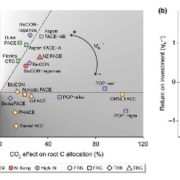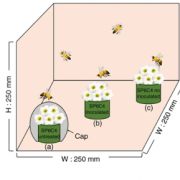Plant scientists’ research attention is skewed towards colourful, conspicuous and broadly distributed flowers (Nature Plants)
 Chicana feminist writer Cherríe Moraga wrote in her anthology This Bridge Called My Back, with regards to the necessary inclusion of women of color in contemporary progressive politics: “It is not always a matter of the actual bodies in the room, but of a life dedicated to a growing awareness of who and what is missing in that room” — this sentiment, describing an awareness of what (or who) is ignored by our implicit biases, is vital in all fields of research/activism. This includes plant biology and conservation. Concepts such as ‘plant awareness disparity’ highlight a relative lack of awareness for plants in biological research, but even within plant research there may be unidentified biases in how certain plant species are selected for study. To determine if biases exist, Adamo et al. focused upon a model system of 113 plant species studied in the Southwestern Alps and performed bibliometrics/trait-based approaches on publications relating to these species. Initial research suggested that morphology and colour were more pertinent traits towards research attention than ecology and rarity. Further research revealed significant relationships between a species’ selection for research and flower colour (particularly striking colours that contrast a brown/green environmental background); plant stem height (a taller plant implies greater conspicuousness); and range size (plants with a broader distribution are perhaps more accessible, thus receiving greater attention). The authors conclude that this data suggests an aesthetic bias in plant research that needs scrutiny for better research practices. (Summary by Benjamin Jin) Nature Plants 10.1038/s41477-021-00912-2
Chicana feminist writer Cherríe Moraga wrote in her anthology This Bridge Called My Back, with regards to the necessary inclusion of women of color in contemporary progressive politics: “It is not always a matter of the actual bodies in the room, but of a life dedicated to a growing awareness of who and what is missing in that room” — this sentiment, describing an awareness of what (or who) is ignored by our implicit biases, is vital in all fields of research/activism. This includes plant biology and conservation. Concepts such as ‘plant awareness disparity’ highlight a relative lack of awareness for plants in biological research, but even within plant research there may be unidentified biases in how certain plant species are selected for study. To determine if biases exist, Adamo et al. focused upon a model system of 113 plant species studied in the Southwestern Alps and performed bibliometrics/trait-based approaches on publications relating to these species. Initial research suggested that morphology and colour were more pertinent traits towards research attention than ecology and rarity. Further research revealed significant relationships between a species’ selection for research and flower colour (particularly striking colours that contrast a brown/green environmental background); plant stem height (a taller plant implies greater conspicuousness); and range size (plants with a broader distribution are perhaps more accessible, thus receiving greater attention). The authors conclude that this data suggests an aesthetic bias in plant research that needs scrutiny for better research practices. (Summary by Benjamin Jin) Nature Plants 10.1038/s41477-021-00912-2









